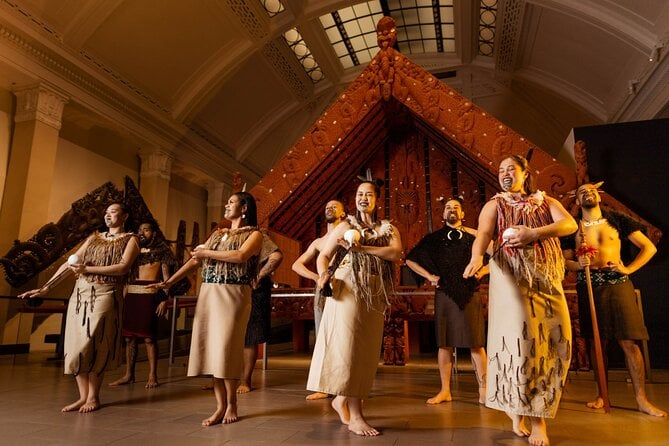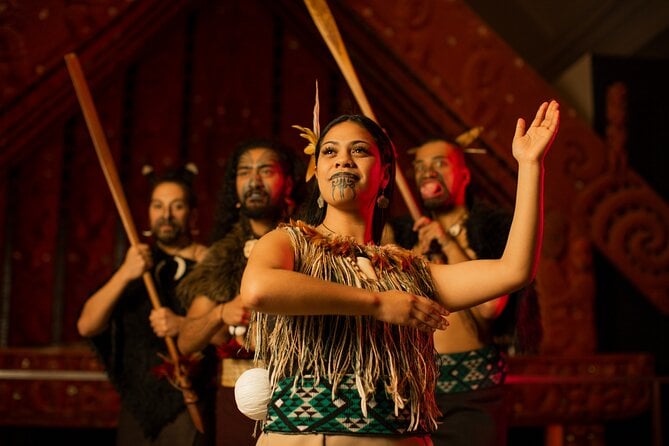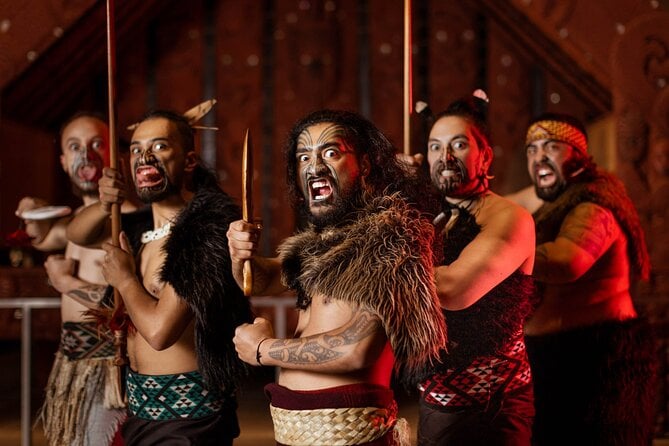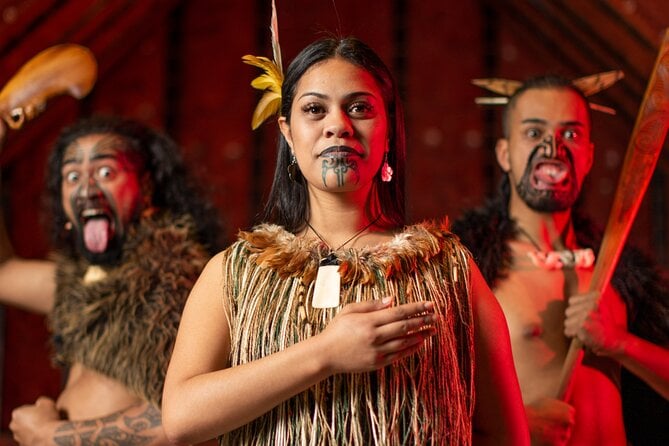While some may view Māori Cultural Performances as mere displays of entertainment, there is much more to these captivating showcases than meets the eye. Steeped in centuries of tradition and cultural significance, Māori Cultural Performances offer a profound insight into the customs and values of the indigenous Māori people of New Zealand.
From the thundering rhythms of the haka to the haunting melodies of ancient songs, these performances transport audiences to a world filled with history, spirituality, and storytelling. But there is a deeper story waiting to be told, one that explores the origins, authenticity, and impact of these performances on both the preservation of Māori culture and the education of a global audience.
So, step into the enchanting realm of Māori Cultural Performance, and discover the fascinating tapestry of traditions that continue to captivate hearts and minds around the world.
Good To Know

- Māori cultural performance is deeply rooted in ancient times and celebrates the heritage of the Māori people.
- Traditional Māori arts, such as weaving, carving, and storytelling, play a significant role in preserving and strengthening cultural heritage.
- Māori cultural performances incorporate elements such as powerful haka, haunting waiata, and skillful poi dances to convey important stories and connections to Māori culture.
- Engaging with a Māori cultural performance requires respectful behavior, dressing modestly, active listening, and cultural sensitivity to fully appreciate and embrace the experience.
Origins and History

The origins and history of Māori cultural performance can be traced back to ancient times, providing a rich and fascinating glimpse into the traditions and customs of the indigenous people of New Zealand.
Māori cultural performance is deeply rooted in the cultural traditions of the Māori people, who’ve inhabited New Zealand for over a thousand years. These performances serve as a way to celebrate and preserve their unique heritage.
Māori cultural performances often include traditional dances, songs, and storytelling, all of which are passed down through generations. These performances aren’t only a form of entertainment but also a way to connect with their ancestors and honor their cultural identity.
The Māori people take great pride in their cultural traditions and continue to showcase them through their captivating performances today.
Find more activities and experiences we've covered in Auckland.
Traditional Māori Arts
Traditional Māori arts come alive through captivating performances that showcase the rich cultural heritage of the Māori people. These arts have a deep historical significance and are a vital part of Māori identity.
Here are three important aspects of traditional Māori arts:
Māori arts preservation: The Māori people have taken great measures to preserve their traditional arts. Through dedicated efforts, ancient techniques and knowledge have been passed down through generations, ensuring the continued practice and existence of these art forms.
Māori arts education: Education plays a crucial role in keeping traditional Māori arts alive. Schools, cultural centers, and community organizations offer programs that teach Māori arts, including weaving, carving, and storytelling. These educational initiatives not only pass on valuable skills but also foster a deeper understanding and appreciation of Māori culture.
Cultural significance: Traditional Māori arts hold immense cultural significance. They serve as a medium for storytelling, spiritual connection, and the expression of identity. Each art form, from the intricate patterns in weaving to the detailed carvings on meeting houses, carries the stories and values of the Māori people. By engaging in these arts, Māori individuals and communities strengthen their cultural heritage and maintain a sense of pride and belonging.
Cultural Significance

Cultural significance shines through every aspect of traditional Māori arts, revealing the profound connection between the art forms and the identity of the Māori people. These cultural traditions have been passed down through generations, serving as a way to preserve the rich heritage and values of the Māori community. From the intricate carvings on meeting houses to the rhythmic movements of the haka, each art form holds deep meaning and symbolism. Through these expressions of cultural significance, the Māori people are able to maintain a strong sense of pride and belonging. Cultural preservation is essential in ensuring that these traditions continue to be cherished and celebrated. It allows future generations to connect with their roots and understand the importance of their cultural heritage. The table below highlights some key aspects of Māori cultural performance and their significance:
| Art Form | Description | Significance |
|---|---|---|
| Haka | Powerful dance | Represents strength and unity |
| Whakairo | Carving | Tells stories and preserves history |
| Waiata | Song | Evokes emotions and shares knowledge |
| Poi | Dance | Celebrates femininity and dexterity |
| Kapa Haka | Group performance | Fosters community and cultural pride |
Through these art forms, the Māori people are able to express their cultural identity, pass on their traditions, and ensure the preservation of their unique heritage for generations to come.
Authentic Performances
As the Māori cultural performance unfolds, spectators are transported into an immersive experience that authentically showcases the vibrant traditions and customs of the Māori people.
The performers, adorned in traditional attire, mesmerize the audience with their powerful haka, a ceremonial dance that embodies strength and unity.
The haunting melodies of the waiata, or traditional songs, resonate throughout the venue, evoking a deep sense of connection to Māori culture.
Through intricate poi dances, the performers skillfully tell stories of their ancestors and their deep connection to the land.
These authentic performances not only entertain, but also serve as a means of Māori cultural preservation, ensuring that the traditions and customs of the Māori people are passed down through generations.
Plus, these performances foster cultural exchange, allowing spectators to gain a deeper understanding and appreciation for the rich heritage of the Māori people.
Key Elements of a Māori Cultural Performance

A Māori cultural performance captivates audiences with its dynamic blend of dance, music, and storytelling. Traditional dances play a significant role in showcasing the rich Māori culture.
These dances, known as haka and poi, are powerful and energetic, filled with rhythmic movements and gestures that convey important stories and legends. The haka, performed by a group of warriors, is characterized by vigorous stomping, chanting, and facial expressions that exude strength and determination.
On the other hand, poi dances involve the graceful swinging of balls attached to cords, creating a mesmerizing visual spectacle. Storytelling techniques are also integral to Māori cultural performances. Through songs, chants, and dramatic gestures, performers skillfully narrate ancient tales, sharing the wisdom, history, and values of the Māori people.
These key elements combine to create an immersive and unforgettable experience for all who witness a Māori cultural performance.
Popular Māori Performance Groups
One of the most renowned Māori performance groups, known for their captivating shows and authentic cultural expressions, is Te Whānau-ā-Apanui. This group has gained recognition for their mesmerizing performances that showcase the rich traditions and customs of the Māori people.
With their powerful haka, graceful waiata, and intricate poi dances, Te Whānau-ā-Apanui brings the spirit of Māori culture to life on stage. Their performances aren’t only a visual spectacle but also a profound cultural experience, leaving audiences in awe of the beauty and power of Māori traditions.
Te Whānau-ā-Apanui is just one example of the many talented Māori performance groups that bring their unique artistry to Māori cultural showcases around the world. Other notable groups include Ngāti Kahungunu and Ngāti Porou, who also captivate audiences with their dynamic performances.
Tips for Experiencing a Māori Cultural Performance
Te Whānau-ā-Apanui and other talented Māori performance groups bring their captivating shows and authentic cultural expressions to life, leaving audiences in awe of the beauty and power of Māori traditions.
Now, let’s explore some tips for experiencing a Māori cultural performance.
When attending a Māori cultural performance, it’s important to respect the traditions and customs of the Māori people. One aspect of this is dressing etiquette. It’s recommended to dress modestly and respectfully, avoiding revealing or inappropriate clothing. This shows your appreciation for the cultural significance of the performance.
To fully learn about the experience, embrace the opportunity to learn about Māori culture. Take the time to educate yourself about Māori customs, traditions, and protocols. This will enhance your understanding and appreciation of the performance, allowing you to connect with the performers on a deeper level.
Common Questions

What Is the Significance of MāOri Cultural Performances in Modern New Zealand Society?
Māori cultural performances hold significant influence in modern New Zealand society. Through vibrant dances, music, and storytelling, they celebrate and preserve Māori traditions, fostering cultural pride, unity, and understanding among both Māori and non-Māori communities.
How Have MāOri Cultural Performances Evolved Over Time?
Māori cultural performances have evolved over time through a process of adaptation and evolution. As society changes, these performances have adapted to reflect modern influences while still preserving the rich cultural heritage of the Māori people.
What Are Some Common Misconceptions About MāOri Cultural Performances?
Misunderstandings and stereotypes can often cloud people’s perception of Māori cultural performances. It is important to debunk these misconceptions and recognize the rich cultural significance and authenticity of these performances.
Are MāOri Cultural Performances Only Performed by MāOri People?
Māori cultural performances are not only performed by Māori people. They embrace cultural inclusivity and often feature non-Māori performers who have a deep respect and understanding of Māori traditions, enhancing the overall experience.
How Do MāOri Cultural Performances Contribute to the Preservation and Promotion of MāOri Culture?
Māori cultural performances play a vital role in preserving and promoting Māori culture. Through traditional dances, songs, and storytelling, these performances keep the customs alive and educate others about the rich heritage of the Māori people.
The Sum Up
To sum it up, Māori Cultural Performances provide a captivating and immersive experience that allows visitors to explore the rich traditions and vibrant customs of the indigenous Māori people of New Zealand. These performances not only preserve cultural heritage but also educate and entertain audiences from around the world.
Through the powerful haka dances, melodious songs, and captivating storytelling, Māori Cultural Performances offer a glimpse into the deep-rooted customs, traditions, and values that shape Māori identity. It’s an unforgettable journey into the heart of Māori culture.
More Tour Reviews in Auckland
Looking for something different? Other Auckland activities we've written about
- Waiheke Island: The Essence of Waiheke Wine Tour
- From Auckland: Hobbiton and Waitomo Day Tour with Lunch
- Auckland: Devonport Waterfront Segway
- 5 Best Workshops And Classes In Auckland
- 8 Best 3 Day Tours In Auckland
- 25 Best Tours In Auckland
- 8 Best 2 Day Tours In Auckland
- 15 Best Canoe And Kayak Experiences In Auckland
- 20 Best Airport Transfers In Auckland
- 20 Best Private Driver Services In Auckland
- 4 Best Drinking Tours In Auckland
- 10 Best Full-Day Tours In Auckland
